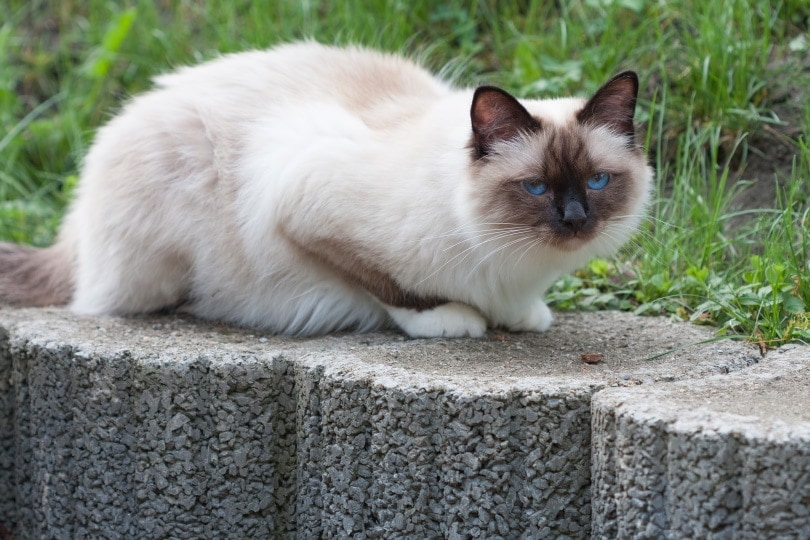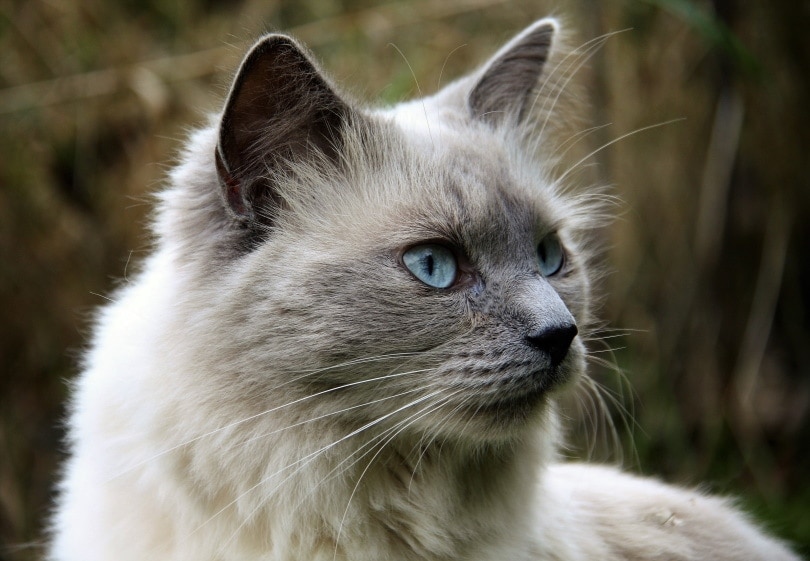Birman Cat vs Himalayan Cat: Pictures, Differences & What to Choose

Updated on

Click to Skip Ahead
The Himalayan’s history is well documented. The breed was created to be a classic Persian with the colorpoint markings of a Siamese. “Colorpoint” means a pale body with darker face, paws, tail, and ears. The Cat Fanciers’ Association categorizes the Himalayan as a “Himalayan Persian” and most cat breed organizations place the Himalayan in the Persian breed group.
The history of the Birman is less clear, but it’s generally thought that a few cats from (possibly) Burma were brought to France around 1920, and the modern breed was developed there. Birmans are not thought to be related to Persians, although there may have been some crossing with the Siamese early on.
Visual Differences

At a Glance
- Origin: Cats from Burma (now Myanmar), brought to France in the early 1900s
- Size: 6–12 pounds
- Lifespan: 9–15 years
- Origin: Persians bred with Siamese for coloring, beginning in the 1950s
- Size: 8–12 pounds
- Lifespan: 12–15 years
Birman Overview

Characteristics & Appearance
The Birman is a lovely medium-haired cat. At first glance, the breed may be mistaken for other fluffy cat breeds like the Himalayan or Ragdoll. Birmans have certain physical characteristics that set them apart from other cat breeds.
Birman kittens are born white and then develop darker coloring on the face, ears, legs, and tail like other colorpoint cat breeds. But then Birman kittens also develop characteristic “gloves”—white coloring on the feet. White coloring going up the backs of the rear legs is called “laces.”
Besides their distinctive gloves and laces, Birmans also always have blue eyes. The Birman’s face is more elongated than the Persian’s. The fur is medium-long and silky and is less prone to matting than the Persian’s thick coat.
The Birman is known for its sweet and gentle temperament. Fans of the breed love its affectionate and social nature. The breed is well-suited to homes with children and other pets.
Himalayan Overview

Characteristics & Appearance
While some early Himalayans looked like true Persian-Siamese mixes, today’s Himalayan cat breed is instantly recognizable as a classic Persian with colorpoint markings. As a member of the Persian breed group, the Himalayan shares the distinctive Persian appearance with other Persians that have different coat colors.
Himalayans have large round heads and eyes, with the characteristic flattened face and a snub nose. The Himalayan’s coat is longer and thicker than the Birman’s and requires regular grooming.
The coat’s dark points can be a variety of colors, including chocolate, seal, blue, flame, cream, and lilac. These points can also be “lynx”—meaning that they have some tabby-like striping.
The Himalayan shares a laid-back personality common to other Persians. While they can be playful and affectionate, they are generally calm and will seek their humans out for attention, pets, and lap time.
What Are the Differences Between the Birman and Himalayan?
The Birman and Himalayan differ in appearance and temperament. While both have blue eyes and pointed coats, it’s hard to confuse a Birman with a Himalayan when you see them side by side.
The Birman has a more traditional long-haired oriental cat look, while the modern Himalayan has a classic Persian face, coat, and body type. Both will have pointed coloring on the face, ears, legs, and tail, but only the Birman will have gloves on all 4 paws, a characteristic of the breed.
The Himalayan’s coat is very dense and long. The Birman’s coat is medium to long, with a silky texture. The Birman has a long, sturdily built body while the Himalayan has the Persian body type known as “cobby”—meaning that it has short thick legs and a deep broad chest.
All cats are individuals, so there are no hard and fast rules about Birman vs Himalayan personality. But generally, Birmans tend to be more social than Himalayans. Himalayans might be less outgoing, but they are calm and affectionate.

Which Breed Is Right for You?
Will your next cat be a Birman or Himalayan? Both are striking cats, with their blue eyes and soft pointed coats. Both are also known as gentle and loving companions. If you prefer the look of a Persian, then the Himalayan—a member of the Persian breed group—just might be for you. The Himalayan may have blue eyes and color points, but the coat texture, body type, and face shape are pure Persian.
Be prepared for daily brushing and combing to keep all the fur in good condition. Many owners also bathe their Himalayans. That cute smushed-in face also requires some grooming as tear stains are possible. The Birman has a more traditional look than the Himalayan in terms of face shape and body style. The fur is also less abundant and easier to care for. The coat is not prone to matting, and a once-weekly combing is usually enough to keep a Birman well-groomed.
Is it easier to find a Birman or a Himalayan kitten? There are more Persian breeders than Birman breeders, but not all Persian breeders will have cats with Himalayan markings. Be sure to check with any breeder if you have specific preferences.
Choose a responsible Birman or Himalayan breeder who is registered with a breed organization and provides health information for their cats. It’s safest to find a local breeder you can visit in person, as many kittens offered for sale online or in pet stores come from large-scale mill operations.
Whichever breed you choose, you can expect your Birman or Himalayan to be your new best friend!
See also:
- Birman Cat vs Balinese Cat: Pictures, Differences, & Which to Choose
- Birman vs Ragdoll Cats: The Differences (With Pictures)
Featured Image Credit: (L) Pixabay | (R) Rob Hainer, Shutterstock












